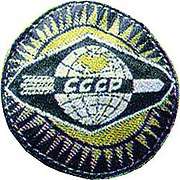Soyuz 14
Soyuz 14 (Russian: Союз 14, Union 14) was a 1974 crewed spaceflight to the Salyut 3 space station. Soyuz 14 is also the name given to the Soyuz spacecraft which was used to bring the cosmonauts to and from the station. The mission was part of the Soviet Union's Almaz program to evaluate the military applications of human spaceflight. The mission's crew members were cosmonauts Yuri Artyukhin and Pavel Popovich. At the time, the military nature of this mission and the station itself were not acknowledged by Soviet authorities. The flight was the first successful mission to a space station by the Soviets.[2] The mission proved to be the only one for Salyut 3 as Soyuz 15 failed to dock with the station in August and the station was de-orbited January 1975. With the American Skylab missions now complete, the flight marked the start of the monopoly of crewed space activities by the Soviets until the 1981 launch of STS 1, the first space shuttle flight, save for the joint Apollo-Soyuz flight of 1975.[3]
| COSPAR ID | 1974-051A |
|---|---|
| SATCAT no. | 07361 |
| Mission duration | 15 days, 17 hours, 30 minutes, 28 seconds |
| Orbits completed | 255 |
| Spacecraft properties | |
| Spacecraft type | Soyuz 7K-T/A9 |
| Manufacturer | NPO Energia |
| Launch mass | 6,800 kilograms (15,000 lb) |
| Crew | |
| Crew size | 2 |
| Members | Pavel Popovich Yuri Artyukhin |
| Callsign | Беркут (Berkut - "Golden Eagle") |
| Start of mission | |
| Launch date | July 3, 1974, 18:51:08 UTC |
| Rocket | Soyuz |
| Launch site | Baikonur 1/5[1] |
| End of mission | |
| Landing date | July 19, 1974, 12:21:36 UTC |
| Landing site | 140 kilometres (87 mi) SE of Dzhezkazgan |
| Orbital parameters | |
| Reference system | Geocentric |
| Regime | Low Earth |
| Perigee altitude | 195 kilometres (121 mi) |
| Apogee altitude | 217 kilometres (135 mi) |
| Inclination | 51.6 degrees |
| Period | 88.6 minutes |
| Docking with Salyut 3 | |
 Soyuz programme (Crewed missions) | |
Crew
| Position | Cosmonaut | |
|---|---|---|
| Commander | Pavel Popovich Second and last spaceflight | |
| Flight Engineer | Yuri Artyukhin Only spaceflight | |
Mission parameters
- Mass: 6,800 kg (15,000 lb)
- Perigee: 195 km (121 mi)
- Apogee: 217 km (135 mi)
- Inclination: 51.6°
- Period: 88.6 min
Mission highlights
With the Salyut 3 space station successfully launched on 24 June 1974, Soyuz 14 was sent into orbit nine days later, on 3 July. The craft docked with the space station the next day, performing a manual approach for the last 100 metres.[3] The crew tested the suitability of Salyut 3 as a crewed military reconnaissance platform. They also tested Almaz station systems, such as the solar arrays.[2]
Increased solar activity raised safety issues, but it was decided radiation levels were within safe limits, so the flight continued.[3]
Experiments were described by the Soviets, but analysts presumed that much time was taken up with unreported military activities. Claims were made in the aerospace press that objects were laid out at the Baikonur Cosmodrome to photograph to test a high-resolution camera system on board.[3] Some of the experiments the Soviets described included studies of the heart and circulatory systems in orbit, studies of intracranial pressure, monitoring of blood composition, measuring of lung capacity and inhalation/exhalation rates and the testing of a water purification system which condensed moisture from the station's atmosphere.[3]
The cosmonauts exercised for two hours each day to counter the effects of weightlessness. Because of this, they were able to climb from their Soyuz descent module without assistance when their flight ended on 19 July. The crew left enough supplies on Salyut 3 to last the next crew at least six months.[2]
References
- "Baikonur LC1". Encyclopedia Astronautica. Archived from the original on 2009-04-15. Retrieved 2009-03-04.
- Newkirk, Dennis (1990). Almanac of Soviet Manned Space Flight. Houston, Texas: Gulf Publishing Company. ISBN 0-87201-848-2.
- Clark, Phillip (1988). The Soviet Manned Space Program. New York: Orion Books, a division of Crown Publishers, Inc. ISBN 0-517-56954-X.
